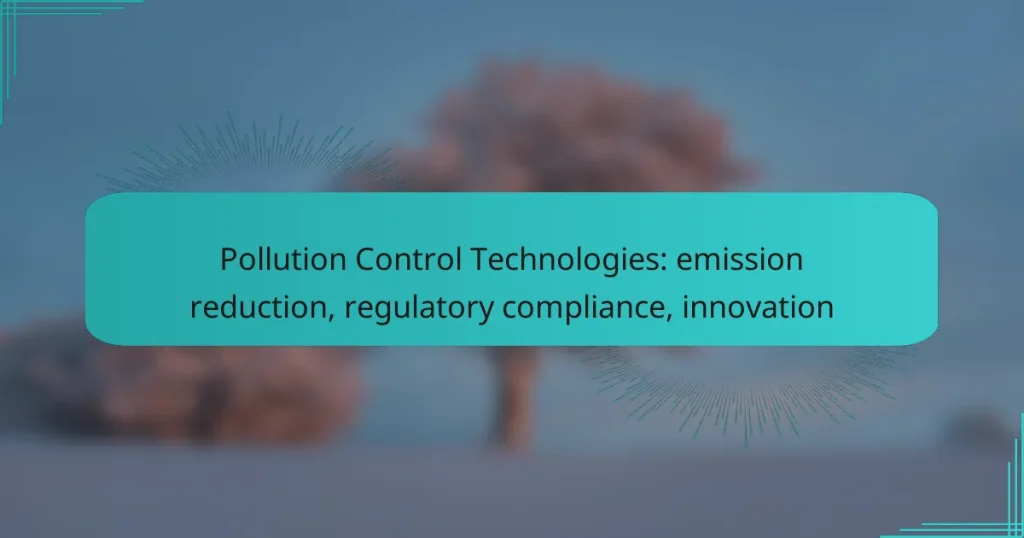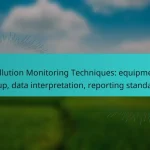Pollution control technologies are essential for reducing harmful emissions and ensuring compliance with environmental regulations. By utilizing advanced systems such as electrostatic precipitators and scrubbers, industries can capture pollutants and neutralize toxic gases, thereby enhancing energy efficiency and minimizing their ecological footprint. These innovations not only help meet regulatory standards but also contribute to a healthier environment for future generations.

What are the best pollution control technologies in Australia?
The best pollution control technologies in Australia include electrostatic precipitators, scrubbers, activated carbon systems, membrane filtration, and biological treatment systems. These technologies are designed to effectively reduce emissions and ensure compliance with environmental regulations.
Electrostatic precipitators
Electrostatic precipitators (ESPs) are devices that use electrical charges to remove particulate matter from exhaust gases. They are highly effective in capturing fine particles, achieving removal efficiencies often exceeding 99%. This technology is commonly used in industries such as power generation and cement manufacturing.
When implementing ESPs, consider factors like the type of particulate matter and the gas flow rate. Regular maintenance is crucial to ensure optimal performance and compliance with Australian air quality standards.
Scrubbers
Scrubbers are systems that use liquid to remove pollutants from gas streams, particularly sulfur dioxide and other acidic gases. They can be either wet or dry, with wet scrubbers being more common in Australia due to their effectiveness in capturing a wide range of contaminants.
Choosing a scrubber involves evaluating the specific pollutants present and the desired removal efficiency. Be mindful of the operational costs and the potential for wastewater generation, which must be managed according to local regulations.
Activated carbon systems
Activated carbon systems are designed to adsorb volatile organic compounds (VOCs) and other harmful pollutants from air and water. These systems are particularly effective for controlling odors and reducing emissions from industrial processes.
When selecting activated carbon systems, consider the type of pollutants and the required contact time for effective adsorption. Regular replacement of the carbon media is necessary to maintain performance and ensure compliance with environmental standards.
Membrane filtration
Membrane filtration is a technology that separates contaminants from liquids using semi-permeable membranes. This method is effective for treating wastewater and can remove a variety of pollutants, including heavy metals and microorganisms.
In Australia, membrane filtration systems are often used in industries such as food processing and pharmaceuticals. It’s important to assess the membrane’s compatibility with the specific contaminants and the overall system’s energy efficiency.
Biological treatment systems
Biological treatment systems utilize microorganisms to break down organic pollutants in wastewater. These systems are widely used in municipal and industrial wastewater treatment, offering a sustainable approach to pollution control.
When implementing biological treatment, consider the type of wastewater and the required treatment capacity. Regular monitoring of microbial activity is essential to ensure effective pollutant degradation and compliance with discharge regulations in Australia.

How do pollution control technologies reduce emissions?
Pollution control technologies reduce emissions by capturing harmful pollutants before they enter the atmosphere, neutralizing toxic gases, and enhancing overall energy efficiency in industrial processes. These technologies play a crucial role in meeting regulatory standards and minimizing environmental impact.
Capture and filter particulates
Capture and filtration systems are designed to remove solid particles from exhaust streams. Technologies such as baghouses and electrostatic precipitators effectively trap dust and particulate matter, preventing them from being released into the air.
For instance, baghouses can achieve particulate removal efficiencies exceeding 99%, making them essential for industries like cement and metal processing. Regular maintenance and monitoring are critical to ensure optimal performance and compliance with local air quality regulations.
Neutralize harmful gases
Neutralizing harmful gases involves chemical processes that convert toxic emissions into less harmful substances. Technologies such as scrubbers and catalytic converters are commonly used to treat gases like sulfur dioxide and nitrogen oxides.
Scrubbers can reduce sulfur dioxide emissions by up to 95% in power plants, while catalytic converters in vehicles significantly lower nitrogen oxides and carbon monoxide levels. Understanding the specific gas composition and regulatory requirements is vital for selecting the appropriate neutralization technology.
Improve energy efficiency
Improving energy efficiency in industrial operations can lead to significant reductions in emissions. By optimizing processes and utilizing energy recovery systems, facilities can minimize fuel consumption and associated pollutants.
For example, combined heat and power (CHP) systems can achieve overall efficiencies of 80% or more, compared to traditional methods that often fall below 50%. Implementing energy audits and investing in modern technologies can help organizations meet both economic and environmental goals.

What are the regulatory compliance requirements for pollution control?
Regulatory compliance for pollution control involves adhering to laws and standards set by government bodies to minimize environmental impact. These requirements vary by country and region, focusing on emission reductions, monitoring, and reporting practices.
National Environment Protection Measures
National Environment Protection Measures (NEPMs) are frameworks established by governments to ensure consistent environmental protection across various sectors. They set out guidelines for air quality, water quality, and waste management, aiming to reduce pollution on a national scale.
Businesses must align their operations with these measures, which often include specific targets for emission reductions. For example, industries may be required to implement technologies that lower greenhouse gas emissions by a certain percentage over a defined period.
State-specific regulations
State-specific regulations complement national measures by addressing local environmental concerns and conditions. Each state may have its own set of rules that dictate permissible emission levels, monitoring requirements, and enforcement mechanisms.
Companies should familiarize themselves with their state’s regulations, as non-compliance can lead to significant fines or operational shutdowns. For instance, a state may impose stricter limits on volatile organic compounds (VOCs) than federal standards, requiring additional controls or reporting.
Emission standards and reporting
Emission standards define the maximum allowable emissions for specific pollutants from various sources, such as factories and vehicles. Compliance with these standards is crucial for maintaining operational licenses and avoiding penalties.
Regular reporting is often mandated to ensure transparency and accountability. Companies may need to submit emissions data quarterly or annually, detailing their performance against established standards. Utilizing software for tracking emissions can streamline this process and help avoid common pitfalls related to inaccurate reporting.

How to choose the right pollution control technology?
Selecting the right pollution control technology involves understanding your specific emission sources, evaluating the effectiveness of available technologies, and considering operational costs. This process ensures compliance with regulations while minimizing environmental impact and maintaining economic viability.
Assess emission sources
Identifying the sources of emissions is the first step in choosing pollution control technology. Common sources include industrial processes, transportation, and energy production. Conducting a thorough emissions inventory helps pinpoint the most significant contributors to pollution.
Utilize monitoring tools and data analysis to quantify emissions. This assessment can reveal patterns and peak times for emissions, allowing for targeted control measures. For example, a manufacturing facility may find that specific machinery contributes disproportionately to overall emissions.
Evaluate technology effectiveness
Once emission sources are identified, evaluate the effectiveness of various pollution control technologies. Consider technologies such as scrubbers, filters, and catalytic converters, which can reduce emissions by significant percentages. Research case studies and industry benchmarks to understand the performance of these technologies in similar applications.
It’s essential to assess not only the reduction rates but also the technology’s adaptability to your specific needs. Some technologies may perform well under certain conditions but fail to meet regulatory standards in others. A pilot test can provide valuable insights into real-world effectiveness.
Consider operational costs
Operational costs play a crucial role in selecting pollution control technology. These costs include installation, maintenance, energy consumption, and potential downtime. A technology with a lower initial investment may incur higher long-term operational costs, making it less economical over time.
Conduct a cost-benefit analysis to compare different technologies. Factor in potential savings from reduced fines for non-compliance and the benefits of improved air quality. For instance, a technology that costs more upfront but offers lower operational costs and higher efficiency may be the best choice in the long run.

What are the costs associated with pollution control technologies?
The costs of pollution control technologies can vary significantly based on the type of technology, the scale of implementation, and the specific regulatory requirements. Businesses must consider both initial capital expenditures and ongoing operational costs when evaluating these technologies.
Initial investment costs
Initial investment costs for pollution control technologies typically include equipment purchase, installation, and any necessary infrastructure upgrades. For instance, installing a scrubber system can range from tens of thousands to millions of USD, depending on the size of the facility and the complexity of the system.
It’s essential to conduct a thorough cost-benefit analysis before committing to a specific technology. Consider factors such as potential savings from reduced fines, lower energy consumption, and improved efficiency, which can offset initial costs over time.
Operational and maintenance costs
Operational and maintenance costs are ongoing expenses associated with running pollution control technologies. These costs can include energy consumption, routine maintenance, and personnel training. For example, a facility using a catalytic converter may incur annual maintenance costs that amount to a few thousand USD.
Regular maintenance is crucial to ensure optimal performance and compliance with regulations. Companies should budget for these costs and consider them when evaluating the long-term viability of pollution control solutions.
Regulatory compliance costs
Regulatory compliance costs arise from the need to meet local, national, or international environmental standards. These costs can include fees for permits, monitoring, and reporting, which can add up to thousands of USD annually. Companies may also face penalties for non-compliance, making it essential to invest in reliable pollution control technologies.
Staying informed about changing regulations is vital. Businesses should allocate resources for compliance management to avoid unexpected costs and ensure they meet all legal requirements.
Long-term financial implications
Investing in pollution control technologies can have significant long-term financial implications. While the upfront costs may be high, effective pollution control can lead to reduced liability, lower insurance premiums, and enhanced corporate reputation. Over time, these benefits can translate into substantial savings.
Moreover, companies that proactively adopt pollution control measures may qualify for government incentives or grants, further offsetting costs. It’s advisable to explore available financial support options when planning investments in pollution control technologies.


